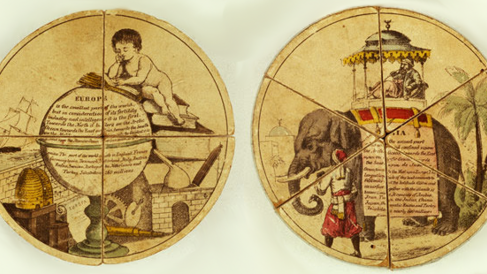A Jigsaw Puzzle Globe

Twenty two jigsaw puzzle pieces fit together to make up this globe, which was intended for use in children's education, probably in the home. Made in the 1870s from wood covered with printed paper, the globe reflects contemporary attitudes regarding other lands and peoples.
Contemporary education
Geography was widely studied in 19th-century England, and was considered important in training the next generation to sustain the Empire. Globes of the heavens and Earth were used in the schoolroom, as well as dissected maps, predecessors of today's jigsaw puzzles. The traditions of globes and dissected puzzles combine in the Kapp globe, with simplified maps that were easy for young learners to understand.
This vowel sounder, known as an "automatic phonograph", from the Whipple Museum's collection was designed by the German-born engineer J. M. Augustus Stroh (1828-1914) and built by W. Groves. It is one of the many so-called 'talking machines' that were constructed in the late 19th and early 20th centuries, along with Helmholtz's synthesizer and eventually Edison's phonograph. This was a period of great public and scientific interest in the potential for the recording and transmission of sound. This machine was used by William Preece and Augustus Stroh in demonstration of their paper Studies in Acoustics: On the Synthetic Examination of Vowel Sounds to the Royal Society in February 1879.
A globe for the British market
The Kapp globe is a poor quality copy of an object first made in Germany, as were many of the toys sold in English toyshops in the 19th century. It bears no date, but examination of the cartography suggests that it was made in the mid-1870s. The 'Ch. Kapp' named in the inscription is unknown, but the name may have been falsely inscribed so as to link the object to the Kapp family, who were established German mapmakers. The mention of Nuremberg also tied the globe to the respected tradition of toy making based in that city. Europe is represented favourably on the globe as a centre of learning and culture - note the books, telescopes and artist's palette on the image above, as well as the ship and the beehive, symbolising trade and industry. This suggests that the intended audience was European, and Great Britain in particular is shown to be larger than it should be on the outer surface of the globe.
Parallels with textbooks
Themes from contemporary English textbooks are reflected in the Kapp globe. The text on the horizontal layers of the globe includes the same kinds of facts that children read in books, such as the dimensions of the continents. Additionally, images reinforce information about the indigenous peoples of foreign lands, presenting attitudes that often differ greatly from modern ways of thinking. Contemporary authors asserted that laziness was constantly found in the warmer climates and also discussed the injustices of the Indian caste system. These themes are present in the globe's image of Asia, above, which shows a servant and his master in command, reclining on an elephant.
This article is based on the work of Sophie Crossfield, 'A study of a 19th century jigsaw globe from the Whipple collection', submitted for the BA Degree, 1999, and Sebastien Kohon, 'Geography as a game: The case of a puzzle globe', submitted for the M.Phil Degree, 1999.
Katie Taylor
Katie Taylor, 'A jigsaw puzzle globe', Explore Whipple Collections, Whipple Museum of the History of Science, University of Cambridge, 2009.
